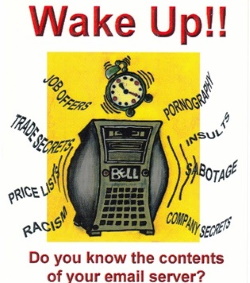
Emails long ago evolved to be around about eighty-percent plus of business correspondence. Most records managers also realize that most of us aren’t managing emails well and that this has left a potentially lethal compliance and legal hole to plug.
I have written numerous papers and posts on the need to manage emails, such as:
The need to manage emails differently to paper;
Managing Emails, how hard can it be?;
I am willing to bet you are still not managing your emails effectively;
How to simplify Electronic Document & Email Management;
Why are your staff still manually capturing & classifying electronic documents & emails?
The need to manage Emails?;
Six reasons why organizations do not manage Emails effectively;
When I review them today, they are just as relevant as they were years ago. That is to say, despite the plethora of email management tools now available, many organizations still do not manage their emails effectively or completely.
The Manual Model
As an recent example we had an inquiry from the records manager at a US law firm who said she needed an email management solution but it had to be a ‘manual’ one where each worker would decide if and when and how to capture and save important emails into the records management system. She went on to state emphatically that under no circumstances would she consider any kind of automatic email management solution.
We have to provide multiple options, such as GEM and the Button, because that is what the market demands but it is common sense that any manual system cannot be a complete or consistent solution. If you leave it up to the discretion of the end user to decide which emails to capture and how to capture them, then you will inevitably have an incomplete and inconsistent store of emails. Worse still, you will have no safeguards against fraudulent or dishonest behavior.
Human beings are, by definition, ‘human’ and not perfect. We are by nature inconsistent in our behavior on a day to day basis; we forget things and sometimes we make mistakes. We are not robots or cyborgs and consistent, perfect behavior is beyond us.
As humans, we cannot be trusted to always analyze, capture and classify emails in a one-hundred percent consistent manner.
The problem is exacerbated manifold when we have hundreds or even thousands of inconsistent humans (your staff) all being relied upon to behave in an entirely uniform and consistent manner. It is ludicrous to expect entirely uniform and consistent behavior from your staff and it is bad practice and just plain foolish to roll out an email management system based on this false premise. It will never meet expectations. It will never plug all the compliance and legal holes and you will remain exposed no matter how much money you throw at the problem (e.g., training, training and re-training).
The Automatic Model
The only complete solution is one based on a fully-automatic rules or AI driven model whereby all incoming and outgoing emails are analyzed at the email server level according to a set of business rules tailored to your specific needs. This is the only way to ensure that nothing gets missed. It is the only way to ensure that you are in fact plugging all the compliance and legal holes and removing exposure and risk.
The fully automatic option is also the most cost-effective by a huge margin.
The manual approach requires each and every staff member to spend (waste?) valuable time every single day trying to decide which emails to capture and then actually going through the process time and time again. It also requires some form of a license per employee or per desktop. This license has a cost and it also has to be maintained, again at a cost.
The automatic approach doesn’t require the employee to do anything except know how to search for emails in your EDRMS. It also doesn’t require a license per employee or desktop because the software runs in the background talking directly to your email server. It is a low cost, low impact and asynchronous solution.
The automatic model increases productivity and lowers costs. It also provides a complete and entirely consistent email management solution and at a significantly lower cost than any ‘manual’ model. So, why is it so hard to convince some records managers and /or business owners to go with the fully automatic solution?
Who Decides?
This is not a decision that should be left up to the records manager. Emails are the business of all parts of any organization; they don’t just ‘belong’ to the records management department. Emails are an important part of most business processes particularly those involving clients and suppliers and regulators. That is, the most sensitive parts of your business. The duty to manage emails transects all vertical boundaries within any organization. The need is there in accounts and marketing and engineering and in support and in every department.
The decision on how to manage emails should be taken by the CEO or at the very least, the CIO with full cognizance of the risks to the enterprise of not managing emails in a one-hundred percent consistent and complete manner.
Its Risk Management
In the end email management isn’t in fact about email management, it is about risk management. If you don’t understand that and if you don’t make the necessary decisions at the top of your organization, you are bound to suffer the consequences in the future.
Are you going to wait for the first lawsuit or punitive fine before taking action?